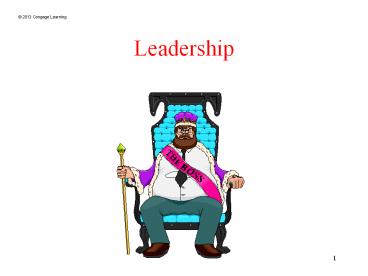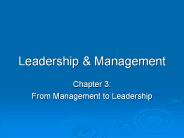Leadership - PowerPoint PPT Presentation
Title:
Leadership
Description:
Leadership * * How are leaders, managers, administrators, and supervisors different? * Leadership Characteristics Leader Emergence Traits Intelligence Openness to ... – PowerPoint PPT presentation
Number of Views:226
Avg rating:3.0/5.0
Title: Leadership
1
Leadership
2
Let's Talk
How are leaders, managers, administrators, and
supervisors different?
3
Leadership Characteristics Leader Emergence
- Traits
- Intelligence
- Openness to experience
- Extraversion
- Conscientiousness
- Emotional stability
- High self-monitoring
- Leadership emergence seems to be stable across
the life-span
4
Leadership Characteristics Leader Emergence
- Motivation to Lead
- Affective identity motivation
- Noncalculative motivation
- Social normative motivation
5
Leadership Characteristics Leader Performance
- Traits
- Needs
- Task- versus person- orientation
- Unsuccessful leaders
6
Traits
- Intelligence
- Charisma
- Dominance
- Energy
- Extraversion
- Openness to experience
- Agreeableness
- Emotional stability
- Self-monitoring
7
Individual Differences and Leader Emergence and
Performance
Trait Corrected Correlations Corrected Correlations Meta-analysis
Trait Emergence Performance Meta-analysis
Personality
Neuroticism - .24 -.22 Judge et al. (2002)
Extraversion .33 .24 Judge et al. (2002)
Openness .24 .24 Judge et al. (2002)
Agreeableness .05 .21 Judge et al. (2002)
Conscientiousness .33 .16 Judge et al. (2002)
Self-monitoring .21 Day et al. (2002)
Intelligence .25 .27 Judge et al. (2004)
Need for Ach .23 Argus Zajack (2008)
8
Needs
- Types of Needs
- Power
- Achievement
- Affiliation
- Leadership Motive Pattern
- High need for power
- Low need for affiliation
9
Task Versus Person Orientation
- Person-Oriented Leaders
- act in a warm, supportive manner and show concern
for the employees - believe employees are intrinsically motivated
- Task-Oriented Leaders
- set goals and give orders
- believe employees are lazy and extrinsically
motivated
10
Relationship Among Theories
Person Orientation
High Country club (MG) Consideration (OS) Theory Y Team (MG)
High Country club (MG) Consideration (OS) Theory Y Middle-of-the-Road (MG) Middle-of-the-Road (MG) Team (MG)
Low Middle-of-the-Road (MG) Middle-of-the-Road (MG) Task-centered (MG) Initiating structure (OS) Theory X
Low Impoverished (MG) Impoverished (MG) Task-centered (MG) Initiating structure (OS) Theory X
Low
High Task Orientation
11
Consequences of Leader Orientation
12
Unsuccessful Leaders(Hogan, 1989)
- Lack of training
- Cognitive deficiencies
- Personality problems
- paranoid/passive-aggressive
- high likeability floater
- narcissist
13
Unsuccessful Leader BehaviorRasch et al. (2008)
- Engaging in illegal and unethical behavior
- Avoiding conflict and people problems
- Demonstrating poor emotional control (e.g.,
yelling and screaming) - Over-controlling (e.g., micromanaging)
- Demonstrating poor task performance
- Poor planning, organization, and communication
- Starting or passing on rumors or sharing
confidential information - Procrastinating and not meeting time commitments
- Failing to accommodate the personal needs of
subordinates - Failing to nurture and manage talent
14
Interaction Between the Leader and the Situation
- Situational Favorability
- Organizational Climate
- Subordinate Ability
- Relationships with Subordinates
15
Situational FavorabilityFiedlers Contingency
Model
- Least-Preferred Coworker Scale
- Situation Favorability
- high task structure
- high position power
- good leader-member relations
- High LPC leaders best with moderate favorability
and Low LPC leaders best with low or high
favorability
16
Relationship Between LPC Scores and Group Success
High LPC Score Low Performance High Performance Low Performance
Low LPC Score High Performance Low Performance High Performance
Low Moderate High
Situation Favorability Situation Favorability Situation Favorability
17
Organizational ClimateIMPACT Theory
- Leadership Style
- Information
- Magnetic
- Position
- Affiliation
- Coercive
- Tactical
- Ideal Climate
- Ignorance
- Despair
- Instability
- Anxiety
- Crisis
- Disorganization
18
IMPACT Leadership Strategies
- Find a climate consistent with your leadership
style - Change your leadership style to better fit the
existing climate - Change your followers perception of the climate
- Change the actual climate
19
Subordinate AbilityPath-Goal Theory
- Instrumental style
- plans, organizes, controls
- Supportive style
- shows concern for employees
- Participative style
- shares information and lets employees participate
- Achievement-oriented style
- sets challenging goals and rewards increases in
performance
20
Subordinate AbilitySituational Leadership Theory
21
Relationships with SubordinatesLeader-Member
Exchange (LMX) Theory
- Concentrates on the interactions between leaders
and subordinates - Subordinates fall into either the
- in-group
- out-group
- In-group employees
- More satisfied
- Higher performance
- Less likely to leave
22
Leadership Through Decision Making
- Vroom-Yetton Model
http//www.youtube.com/watch?vwI06amxoqtI
23
(No Transcript)
24
Leadership Through Contact
- Management by walking around
http//www.youtube.com/watch?vXo1ZWvtX_ZMfeature
youtu.be
25
Leadership Through Power
- Expert Power
- Legitimate Power
- Reward Power
- Coercive Power
- Referent Power
26
Leadership Through VisionTransformational
Leadership
- Visionary
- Charismatic
- Inspirational
- Challenge the status-quo
- Carefully analyze problems
- Confident and optimistic
http//www.youtube.com/watch?vPWq5C8TqGjI
27
Authentic Leadership
- Bill George (2003)
- Leaders become self-aware by reflecting on their
own - Ethics
- Core beliefs
- Values
- They lead out of a desire to serve others
http//www.youtube.com/watch?vr6FdIVZJfzgfeature
related
28
Putting it all Together
Applied Case Study Developing leaders at Claim
Jumper Restaurants
29
Let's Talk
Focus on Ethics Ethical Leadership
30
What Do You Think?
- In the first situation, do you think it is
unethical for the professor to bend the rules
under those circumstances? - If you were one of the students failed because of
high absenteeism and you found out that the
professor didnt fail another student for his
high absenteeism, would you think you were being
treated unfairly? - What would you do?
- Do you think what the leaders did in the other
examples was ethical? Why or why not? - In the example with the brother, is it okay to
lie in this situation? - Do you consider lying as unethical?
- Are there ever times when lying is better than
telling the truth? - What are some situations in which bending the
rules might be more ethical than following policy?































